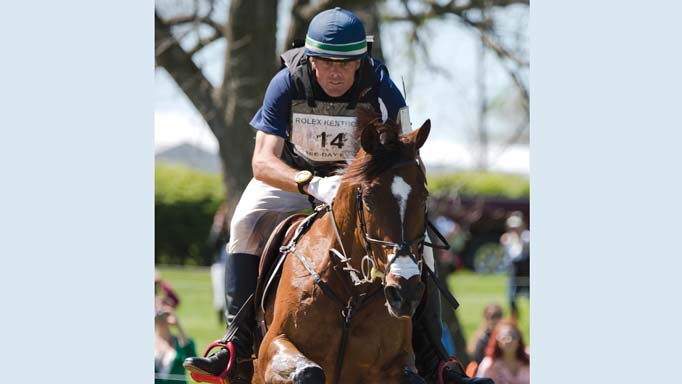With his wife, Jennifer, and two young children, he runs Five Ring Stable out of Ocala, Florida. A fixture on the Canadian eventing scene, it was two unplanned departures from the competitive stage that forced him to re-evaluate his future in the sport and saw him return with renewed ambition in 2014.
While competing at Red Hills in the spring of 2011, Carter sustained a serious injury to his wrist that required surgery and two months out of the saddle. While he begrudgingly took a hiatus, it turned out to be a blessing in disguise. “I am responsible for guiding the careers of my students, but realized that I was not giving the same attention or providing the same intel for myself,” he explains. “I had to focus on trying to get the right horses in my barn and working towards the next step.”
Then, in the fall of 2011 at the Blenheim CIC***, Carter suffered another setback when his top horse, Madison Park, injured himself running cross-country. The ligaments that hold the superficial and deep digital flexor tendons in place tore, and the tendons in turn slipped off the hock. It should have been career-ending; it was the very same injury that retired Karen O’Connor’s Biko and Lucinda Green’s Olympic partner Be Fair. After careful consultation with top veterinarians (one of whom is also his father), Carter decided against retiring the Thoroughbred gelding. “We approached it differently, because we recognized Parker couldn’t re-injure it and that it wasn’t going to cause him pain.”
Conventional treatments stabilized the tendons to the point where Parker was comfortable enough to proceed to the next stage in the rehabilitation process. Carter then focused his attention on helping Parker re-learn basic movements. He’d had some experience that proved to be useful; in 1999, his top horse, Scotia Goldrush, suffered the same injury at the Pan Am Games. “We worked on training that leg to match the other leg to move the same way,” he explains. “It was an intensive process that included the underwater treadmill at The Sanctuary [equine rehabilitation centre in Ocala], hydro-therapy in our water jump, trot poles, working in half-steps towards passage, and even canter pirouettes.”
The start box at Rolex in 2014 seemed an unlikely goal, but his remarkable recovery saw Parker come back better than ever, prompting phone calls from other vets. ‘They know how it would be dealt with in a veterinary sense, but that is not how we dealt with it. Most of it for us was intuitive. We always treated him as a unique athlete with a unique injury; we just paid attention every day and made the necessary corrections.’
So why go the extra distance for a horse that statistically was past his prime in the event world? With a team silver at the 2007 Pan Ams and 2010 WEG, and having contested the 2008 Olympic Games, Burghley, and four Rolex CCI**** (finishing 13th in 2010) he certainly didn’t owe his handlers anything. “Parker is part of the family. He’s a real handful, he’s over the top, and we got him at a real bargain because he’s such a pain to work with,” Carter laughs of the now 16-year-old. “Most people would say he has a terrible temperament, but he doesn’t. He’s just a kid in a car seat constantly writhing with energy.
“He’s done so much for me and he’s just never shown any inclination to give up. We have lots of horses come through the barn that are more talented, but as far as his absolute desire to try and to work, his devotion to participate is second-to-none. For a horse that tries so hard for me, how could I not do the same for him?
“We have a better relationship because of it. I listen to him more and don’t tell him as much. I’m a better person for having him around.”

